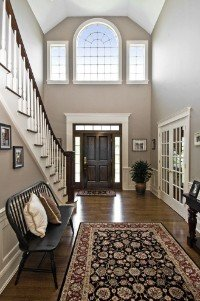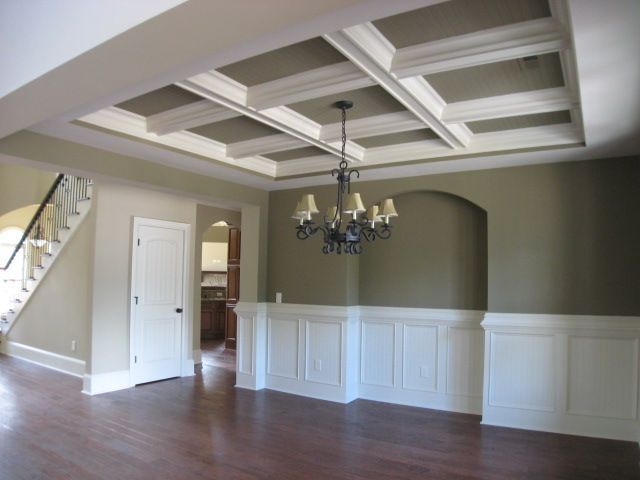Interior Painting
USING OUR COLOR CONSULTANT
When you decide to move forward with us on your painting project, we will provide you with the option of using a professionally trained Sherwin-Williams Personal Color Consultant. During the 90-minute in-home visit, your Personal Color Consultant will create a custom color palette that fits your decorating style. You will also receive product and overall project advice that will help give your space a professional, finished appearance.
PREPARING YOUR HOME INTERIOR FOR PAINT
Homeowners depend on paint to both beautify and protect. When it comes to ensuring that your paint project is a success, there is no more important place to start than room preparation, including cleaning, sanding and priming walls before painting. BrightSide Painting & Remodeling will put the power of paint to your home’s interior. Here are the preparation steps we take to succeed:
Protecting the Project Workspace
Please be patient with us at the start of your project, as we dedicate the time necessary to protect your property, cabinets, countertops, floors and the surrounding work area prior to painting with drop cloths and plastic.
Cleaning Walls Before Painting
Clean walls are key in preparing a room for painting. Most walls can be washed using a sponge and warm water if necessary (kitchen walls, for example). If we have to wash a wall, we must then wait until it is dry before applying primer or paint to the surface in order to avoid blistering.
Sand Surfaces Before Painting
While sanding is not required for every paint project, rough spots on walls, whether they have been previously painted or not, need to be sanded before they are painted to ensure the paint goes on smoothly. All wall defects or repairs involving drywall spackling must be sanded down first.
Smoothing walls before painting is necessary for surfaces previously painted with a gloss or high-gloss paint. For walls that have previously been painted with water-based paint, we will sand with a fine-grit sandpaper, and for oil-based paint, a medium-grit sandpaper (100- to 150-grit) will be used.
Cracking or flaking paint on previously painted surfaces can also be an issue. Paint cracking on walls and ceilings happens due to a variety of causes. One of the most common being poor preparation of a surface prior to painting. Painting over cracked paint is unacceptable, so we will remove any flakes from the surface via sanding or scraping before repainting.
Priming Walls Before Painting
In some instances, a primer will be necessary in order to get the most out of the paint, especially if the walls are porous or have surface stains that need covering up. Primers disguise imperfections, create a smooth surface for your paint to lock onto and ensure a uniform finish no matter what is being painted.
Painting Over Wallpaper
BrightSide Painting & Remodeling does not recommend painting over wallpaper because of how difficult it is to completely hide wallpaper seams. The sole exception being if the removal of the wallpaper would involve drywall damage so significant that the repair cost exceeds the cost of qualified labor needed to remove it.
CHOOSING A SHEEN
Put the finishing statement on your paint color of choice by selecting a sheen that enhances the look of the surface. Sheen, or paint finish, is a measure of how much light reflects off of a painted surface, resulting in gloss or a lack thereof. Some types of paint finishes may work better in certain areas than others.
Sheens and glosses range on a scale from no shine to high shine. Different levels of sheen can affect how colors appear and can add dimension to rooms. While there are many different types of sheen, here are the most common types of paint finishes:
Flat Paint
A flat sheen provides great depth and color and is ideal for less-than-perfect surfaces. Flat paint is a term for a finish that does not reflect light, resulting in no sheen at all. This lack of reflection allows more paint pigment to come through, is more forgiving of flaws and allows for excellent hide, creating a uniform surface. Use caution when considering flat paint in high-traffic areas that require frequent attention. Stains are harder to remove from low-sheen paint, and constant rubbing or cleaning can result in burnishing.
Matte Paint
Matte finish is nearly as shine-free as flat, again providing excellent hide and depth of color, with slightly more durability. Matte finish paint also withstands frequent washing, even when applied in busier areas like hallways and family rooms. A matte look lends a luxurious touch to many interior spaces, including bedrooms and dining rooms.
Eggshell Paint
Eggshell finish, perennially popular with professional and DIY painters alike, has a low-sheen reminiscent of flat or matte, but it is infinitely more durable than its namesake. Eggshell (and its comparable—but not exact—sheen sibling, low lustre) provides an easy-to-clean, nearly shine-free finish, suited for most areas of a home, including family rooms and hallways. While it reflects more light than flat or matte finishes, its soft glow casts colors beautifully and is a great choice for your most-loved spaces.
Satin Paint
Satin sheens are light, easy to clean, work great in high traffic areas, and reveal color with a softly polished glow. Often confused with other finishes, the difference between eggshell and satin paint is that satin delivers a higher gloss, while offering better stain resistance and durability than lower sheens, including eggshell. Satin paint is ideal for areas that crave definition. Use its distinctive lustre to highlight windows, shutters, trim and even interior doors. For front doors, where architectural details like beveling and paneling are customary, consider satin to achieve a rich, lustrous look that evokes a look of elegance and luxury. Also in this category is soft gloss paint, which, while not an exact match for satin paint, offers a similar higher-gloss, better-durability finish.
Pearl Paint
A pearl finish is a medium gloss that maintains high durability. Both beautiful and easy to clean, a pearl finish lends dimension to trim while being optimal for walls in high-traffic areas. It can be used everywhere from wainscoting to doors, and offers mildew resistance for high-humidity areas. When choosing this finish, make sure you follow the manufacturer’s application tips and paint carefully, as paint with a pearl sheen is more susceptible to showing lap marks and other painting flaws.
Semi-Gloss Paint
The luminous look of a semi-gloss paint is perfectly suited to highlight the architectural details of your home and create dimension on millwork, trim, and doors. Semi-gloss is available in most interior paints.
High Gloss Paint
Offering a mirror-like finish, high gloss sits on top of the sheen chart. This finish, offered in some paints, is extremely durable and offers elegant shine. It is easy to clean, stain-resistant and will add a stunning look to doors, trim, and even a high-traffic kitchen. Many interior designers (and adventurous homeowners) like to experiment with high gloss paint in unexpected areas, such as the ceiling or an accent wall. Keep in mind, however, that high gloss paints require careful application and preparation best left to a professional painter. Since a gloss finish reflects light and can accentuate blemishes, avoid using it on areas that are not completely smooth.
SELECTING A COLOR
While there is no one-size-fits-all reply to "What’s the best interior paint color?," some thoughtful research goes a long way. Go into this with an open mind and a commitment to exploring your creative side as you search for your perfect paint color.
Analyze the Room for Interior Paint Ideas
Paint truly transforms your space. The color of your hardwood floors, countertops, a fireplace surround, area rugs, and furniture will help determine which paint color families will work best in your room, and help narrow your options. Additionally, the right paint color for any room should reflect the mood you want to create in the room as well as complement its architecture and style.
Explore the Best Interior Paint Colors for You
For a more deliberate approach seek online websites like Pinterest, online tools such as the Sherwin-Williams ColorSnap Visualizer, and magazines to find colors and color combinations that inspire you. Is your eye drawn to darker hues, fresh pastels or bold primary colors? Explore how paint and color work together.
Get Color Swatches then Paint Samples
Once you’ve selected the colors you’re drawn to, visit your local Sherwin-Williams store and pick up color swatches and inspirational brochures to bring home.
While you may be tempted to use color swatches only to determine which color to use, the best way to test color is to buy paint samples and then view them in different lighting conditions throughout the day. Natural and artificial light can impact the appearance of color, so viewing it at different times of the day in all lighting conditions is crucial.
Pair Color with Quality Paint
Choose BrightSide Painting & Remodeling for a complimentary estimate and we will recommend a name brand quality product that will deliver the color and durability that your specific project requires.




